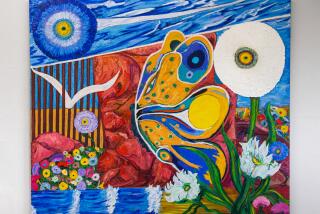The Rent-a-Bug Lady : Collector Deals in Dead Insects of the Creepiest, Most Hideous Kind
- Share via
The three hulking scorpions, positioned for deadly action on Cathy Endfield’s worktable, didn’t get there without a struggle. Because even to an insect pro like Endfield--proprietress of a dead-bug rental business--scorpions are the consummate creepy crawlies, the foot soldiers of nightmares. And since her mission was to get the little buggers dressed for work, it didn’t help that they made her feel, for want of a better word, icky.
“Do you feel like touching that?” she says.
Gee, well, no, and neither did Endfield, not for months after their arrival. But then she’s something of a worker bee herself, and she’s not likely to turn away an opportunity to order and spruce up dead bugs for the stars--or anyone else for that matter.
So when the prop master of a low-budget biker film said that he might need a scorpion for the road, Endfield geared up for production.
For a while, it looked as though any dead bug that passed the audition would be in for it. “He said the guy was gonna kick it and stamp on it,” Endfield says. “I said, ‘Are you going to insure it?’ ”
Now the scorpions are resting on pieces of wood on the worktable of Endfield’s Sherman Oaks home, frozen in space by a blizzard of pins, like so many ailing insect patients in need of acupuncture.
They have plenty of company. Every room in Endfield’s one-bedroom home is filled with dead bugs, thousands of them, many with splendiferous names--purple tarantulas “as big as dinner plates,” military camouflage katydids, bulldog ants, guitar beetles, foot-long walking sticks and, the real grabber, the giant death’s head roach.
“That was the one that got me, the giant death’s head roach,” says Deborah Roundtree, a commercial photographer who was caught in Endfield’s web by the stunning inventory listed on her dead-bug rental service flyer, a missive of which she is particularly proud.
“I think, in fact, it reads almost like a poem,” says Endfield, a large, reclusive woman who laughs easily.
These may be dead bugs to you, but to Cathy Endfield, the giant orbweaving spider is truly a thing of beauty. And, as for the butterflies, well . . .
“Every single time, there’s new colors and new patterns and the stuff isn’t that expensive,” she says dreamily. “The textures are beautiful. Some look like velvet. Some look like silk. They’re iridescent. Sometimes it looks as though the colors are coming from deep inside the wing. With the beetles, it’s a similar kind of thing. Some are pebbled. You look at it the other way, it’s a rainbow.
“That’s what propelled me, I think. It was the excitement of the beauty.”
Not mere beauty, but art, which Endfield regards as her true calling. She creates collages from her stash, and at her odd entomological home, a sunset moth, resplendent in green, auburn and pink, is a palette in itself.
She has boxes and boxes of red wasps from Chile and damsel flies from the Philippines, which take their precisely aligned place beside tiny stars and miniature pictures of Nefertiti, angels and Renaissance women.
“They reminded me of Joseph Cornell boxes, but more with her own obsessions,” says photo stylist Ellen Giamportone, who has rented butterflies from Endfield.
Or, as Endfield, 47, puts it, “This is definitely a fear turned to fascination.”
You see, Endfield understands people like you, a normal insect-hating person. She knows how absolutely, hideously humongous bugs can be. She even bandies about a term, popular among exterminators, “ ‘expanding roaches.’ What that is, is people see this cockroach and it’s an inch, but by the time they call the exterminator, it’s six inches.”
In fact, until Endfield was in her early 20s, she was so squeamish she made the average bug-squashing Joe seem like an insect aficionado.
“I remember when I was pregnant, there was this giant water bug--giant, I mean they’re about an inch--in the house. I saw it run under the bed. My ex-husband took me to a friend’s house to spend the day because I couldn’t be in the house.”
Then one day more than 20 years ago--she has been collecting dead bugs off and on ever since--Endfield happened to send away for the World’s Largest Moth. It came, wings as large as a man’s hand, with a catalogue of butterflies. “Some of them had names like sunset moth. It’ll give the Latin name and it’ll say, ‘Sunset Moth--World’s Most Beautiful Moth.’ You don’t need to see a picture of it to know that for a dollar and a half, you’re probably not going to lose your money. So I sent away.”
From there, it was on to scarabs, for the sheer romance of it “because of my interest in Egypt.” She began ordering blindly from impossibly dense catalogues with thousands of bug names in Latin. She networked with dead-bug dealers from New York to San Diego, from Cleveland to a remote outpost in Ft. Davis, Tex. (There, from a modest base in a trailer, an entomologist and his wife dispense a particularly thorough inventory--”every squishy thing you can imagine”--under the rubric Combined Scientific.)
Endfield’s first really yucky acquisition--a giant orbweaving spider--came in a dead-bug grab bag. Surprise!
“That’s another great thing and much cheaper, you can get grab bags of insects,” Endfield says. “And it’s really great because you can get stuff you don’t know about, and it’s unusual.”
When the bugs arrive, Endfield “relaxes” them, storing them in an airtight box with water or alcohol until they’re pliable enough to be positioned on a board with pins. She likes them to be set just so. Even the dreaded scorpions.
“With the scorpions, for months after I ordered them the first time, I could not make myself work on them. I couldn’t touch them. But what happens is you put it onto the board, you have a certain amount of time before it dries out, and you’ve got to start working.
“You want that claw opened just right. You want the leg in that position, and you want the stinger turned under. You forget. Your repugnance is overcome by the fact that you want this thing to look a certain way, so you do the work. Then afterward you think, ‘Did I really do that?’ ”
Endfield knows she has, shall we say, rarefied tastes.
Take the day she asked one of her dealers why he didn’t restock giant orbweaving spiders. Wasn’t anyone interested? “He said, ‘Let’s put it this way. In five years, you’re the only person who’s expressed any interest.’ ”
Endfield herself has not always been true to her bugs. There were years when her beloved butterflies seemed, well, trite. “It was like a daisy or something. Eventually, I put that stuff away.”
But her insects beckoned anew a few years ago. Soon she was in the “extremely low-volume” bug-renting business. “There’s almost no call for it.”
The intrepid few photographers and filmmakers who borrow Endfield’s stock, for $50 to $100 a specimen, include the expected--her butterflies fluttered down from a tree in the Venezuelan jungle in “Arachnophobia”--as well as the imaginative. One guy wanted to design a sweater covered with Endfield’s moths. And Barbie borrowed special butterflies for a market-research photograph. Special because it was not to Barbie’s liking that most butterflies come in basic black, along with the more ebullient hues.
“The stylist came and she’s looking at the butterflies and she says, ‘No. This is too dark for Barbie. Barbie wouldn’t like these colors. Barbie likes pink.’ ”
Morpho godarti, a pale gray butterfly with pink iridescence, to the rescue.
For each triumph, though, Endfield has a dozen detractors.
“One of the things that bothers me incredibly is I’ve had hate calls from animal rights people. It’s because of the pretty insects. It’s because of the butterflies and moths that also have a face. They’re furry and fluffy. I feel real bad for them myself. If someone said I was making artwork out of roaches and mosquitoes and ants, nobody would complain.
“My understanding is that insects don’t have pain receptors. And I hope it’s true. I also understand they don’t have an emotional life. That makes me happy too. I don’t know if I believe it. Because sometimes to me, it seems like they have a personality. There are certain spider species, they run around my house, they look like they’re having a good time.”
There are the inevitable days when people leave uninviting messages on Endfield’s answering machine. Like the woman who called to say, “ ‘I just want to make a comment.’ What does she think she’s calling, talk radio? This is my home. She says, ‘I’m very disappointed to hear there’s somebody out there making a living’--she should know how much of a living I’m making--’off of living animals.’ So I said, ‘Are you a vegetarian?’ ‘No, I’m not.’ ‘Well, you’re eating animals that feel the same kind of pain that we have when they’re hurt or butchered and they have an emotional life and they raise their young. This is not the case with insects.’
“Eventually, I just hung up, but she wouldn’t see that. I think if somebody is a vegetarian and they don’t kill the ants that are infesting their kitchen, I wonder how these people get the ants out of their house. I mean, it happens to everybody--you wake up one morning, and there’s this black line across the kitchen. These people who don’t kill anything, what do they do? Do they put out extra food or something?”
Actually, Endfield would be the first to let insects crawl out the door to freedom. Because she knows them intimately enough to know they have a little life of sorts, buggy though it may be. And the funny thing is, she wouldn’t hurt a fly.
Says Endfield, ruminating from her bug command post, surrounded by uncounted boxes of metallic green bees, sphinx moths, owl-eyed butterflies and horned rhinoceros beetles: “I think it’s guilt.”
More to Read
The biggest entertainment stories
Get our big stories about Hollywood, film, television, music, arts, culture and more right in your inbox as soon as they publish.
You may occasionally receive promotional content from the Los Angeles Times.










